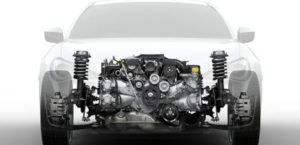The M30B30 engine is the 3.0-liter (2986 cc) version of the M30 engine. The fuel injected version of the 2,986 cc (182.2 cu in) M30 debuted in 1971 in the E9 3.0 CSi and initially used the Bosch D-Jetronic mechanical fuel injection system. In 1976, the fuel injection system was upgraded to Bosch L-Jetronic electronic fuel injection. The M30B30 produces up to 147 kW (200 PS; 197 bhp) and 272 Nm (200 lb⋅ft), depending on the model year and whether a catalytic converter is fitted. The compression ratio is 9.2:1. With catalytic converter, compression ratio is 9:1.
Specifications
| Manufacturer | Munich Plant |
| Also called | M30 |
| Production years | 1971-1994 |
| Cylinder block alloy | cast iron |
| Fuel system | carburetor/injector |
| Configuration | inline |
| Number of cylinders | 6 |
| Valves per cylinder | 2 |
| Piston stroke, mm | 80 |
| Cylinder bore, mm | 89 |
| Compression ratio | 9.0 / 9.2 |
| Displacement, cc | 2986 |
| Power output, hp | 184/5800 / 188/5800 / 197/5800 |
| Torque output, Nm / rpm | 255/3500 / 260/4000 / 275/4000 |
| Fuel type | petrol |
| Weight, kg | ~135 |
| Fuel consumption, L/100 km — city — highway — combined |
16.3 7.6 11.0 |
| Oil consumption, gr/1000 km | up to 1000 |
| Recommended engine oil | 5W-30 / 5W-40 / 10W-40/ 15W-40 |
| Engine oil capacity, liter | 5.75 |
| Oil change interval, km | 7000-10000 |
| Normal engine operating temperature, °C | ~90 |
| Engine lifespan, km | ~400 000 |
Frequent problems
The main problems of BMW M30B30 engines are overheating and cracks in the cylinder block. Overheating is experienced by many owners of 6-cylinder vehicles. In order not to drive the cylinder head, this problem must be solved in a timely manner and not started. The motor overheats due to a dirty pump, radiator, thermostat, in the presence of air jams in the cooling system of the unit.
 Cracks occur after disassembling the motor, when oil is not removed from the threaded wells. They form around the threads of the cylinder head bolts. If you notice an increased consumption of antifreeze, the presence of an emulsion in the oil, this may indicate cracks in the cylinder block. Sometimes they try to solve the problem by repairing, but the masters recommend buying and installing a cylinder block without cracks.
Cracks occur after disassembling the motor, when oil is not removed from the threaded wells. They form around the threads of the cylinder head bolts. If you notice an increased consumption of antifreeze, the presence of an emulsion in the oil, this may indicate cracks in the cylinder block. Sometimes they try to solve the problem by repairing, but the masters recommend buying and installing a cylinder block without cracks.
Due to their long service life, BMW M30B30 engines have problems in the gas distribution mechanism when the valve cannot be adjusted. The solution is to replace eccentrics, bushings and valves.
Problems may affect the mass air flow sensor, since the resource of the units has been outleted, including due to intensive, often aggressive operation.





